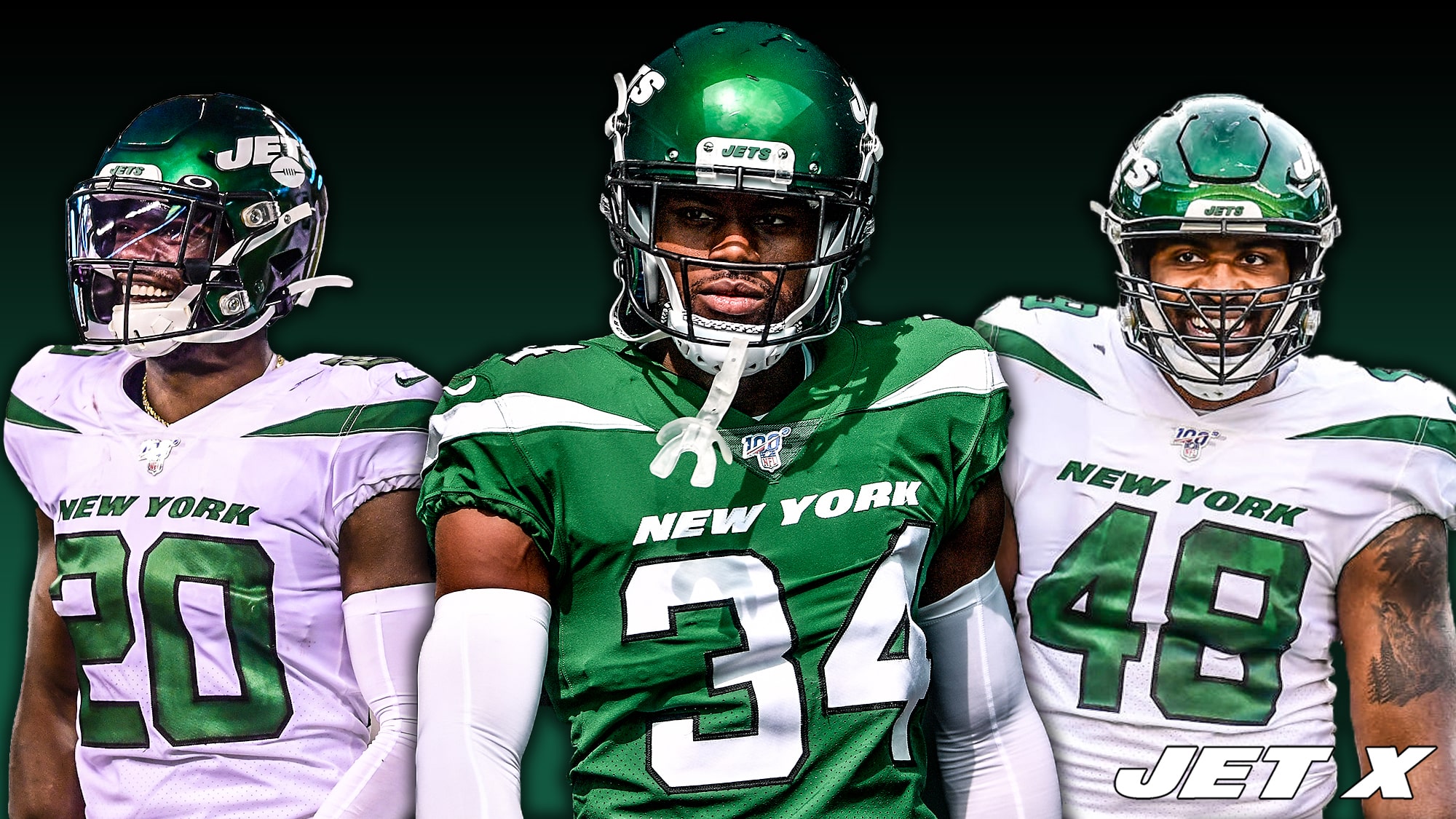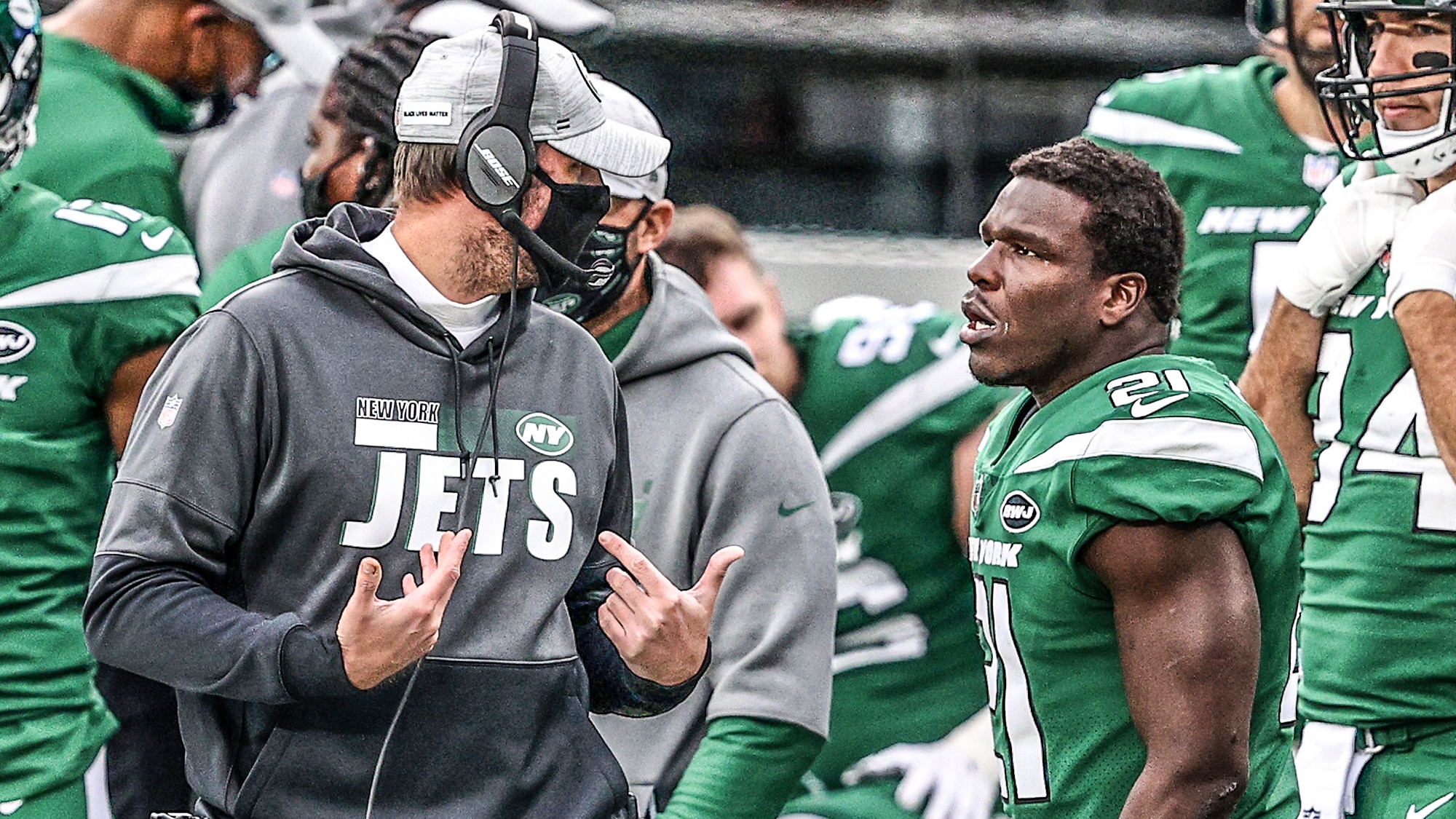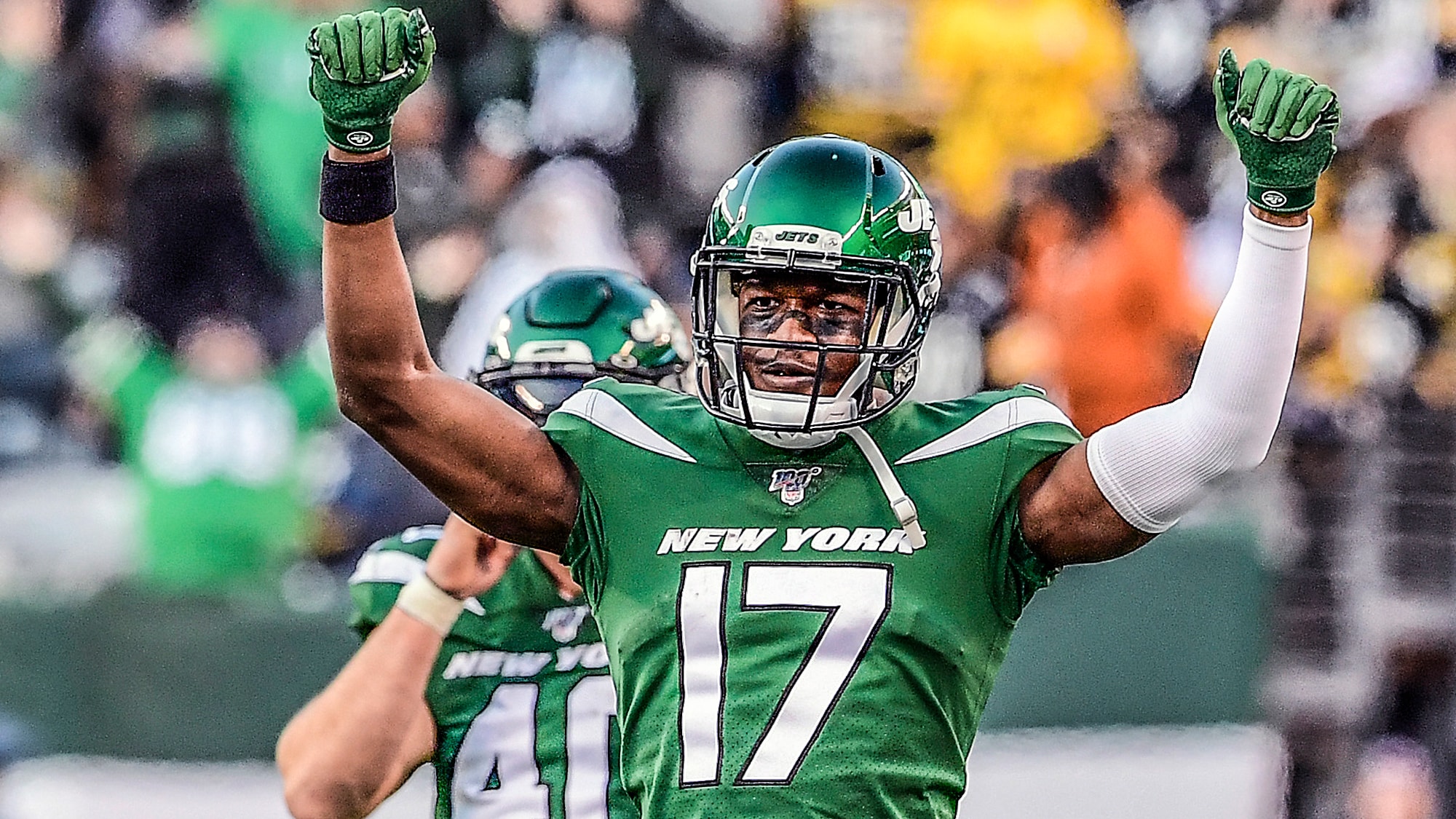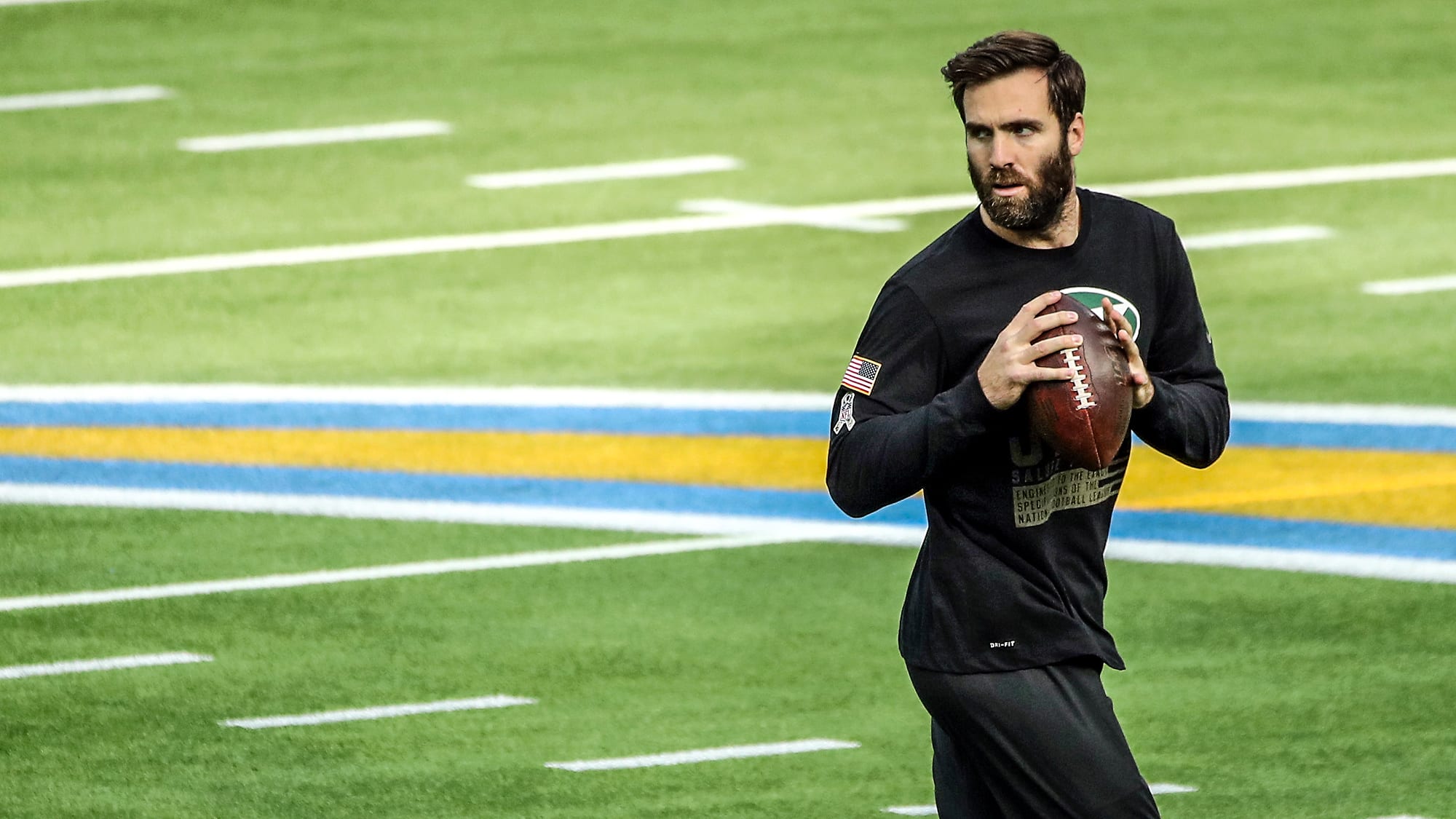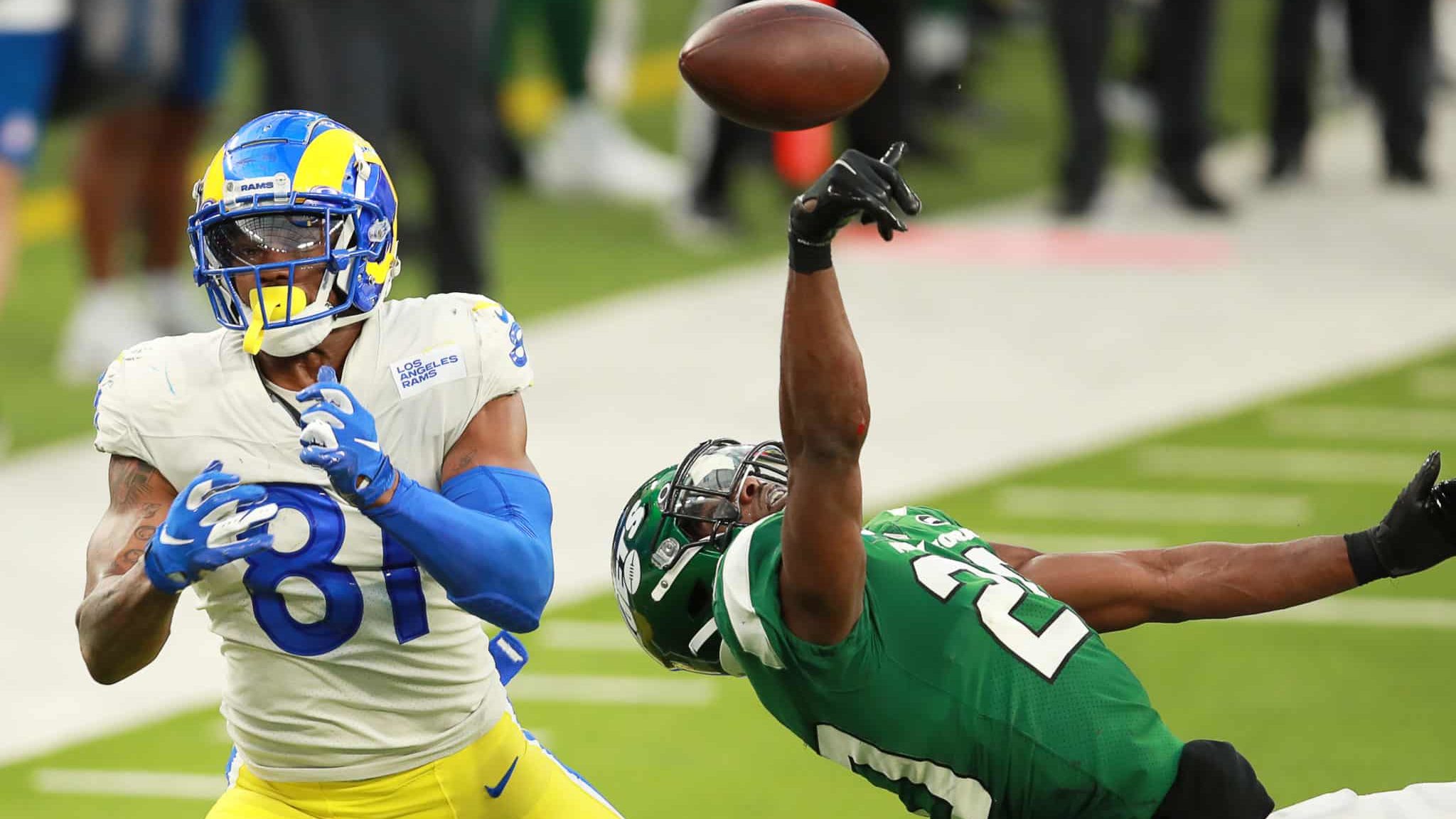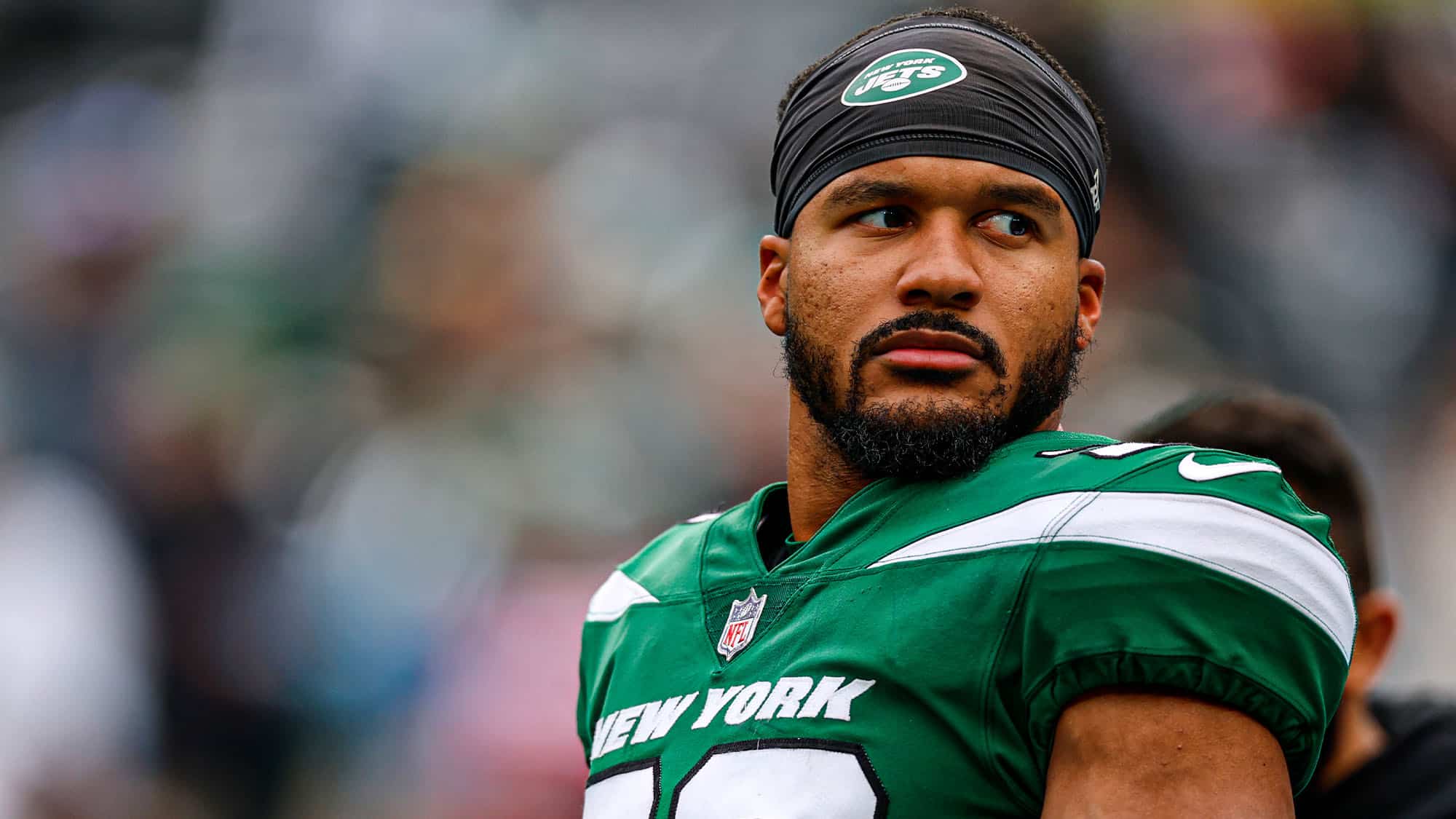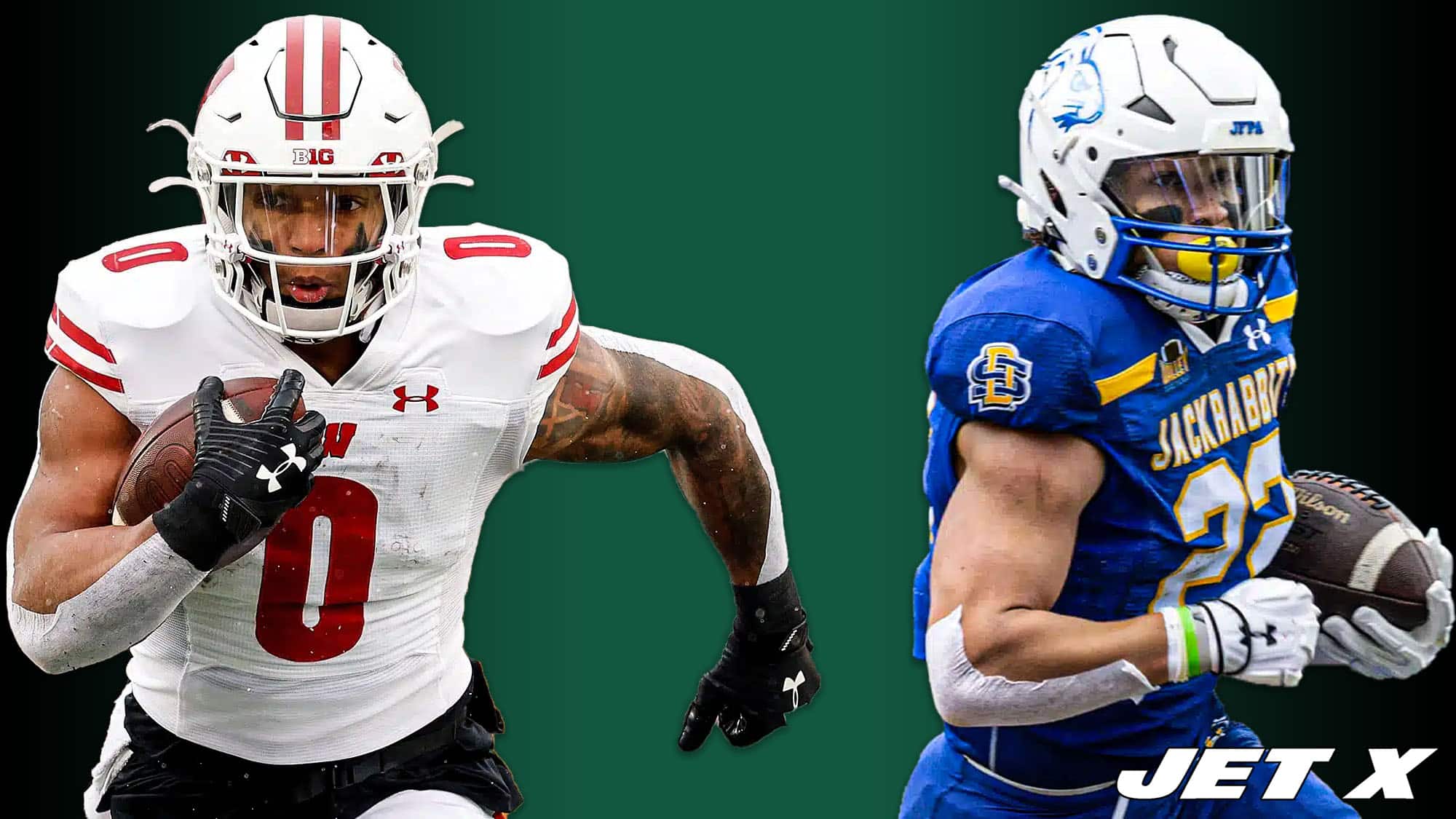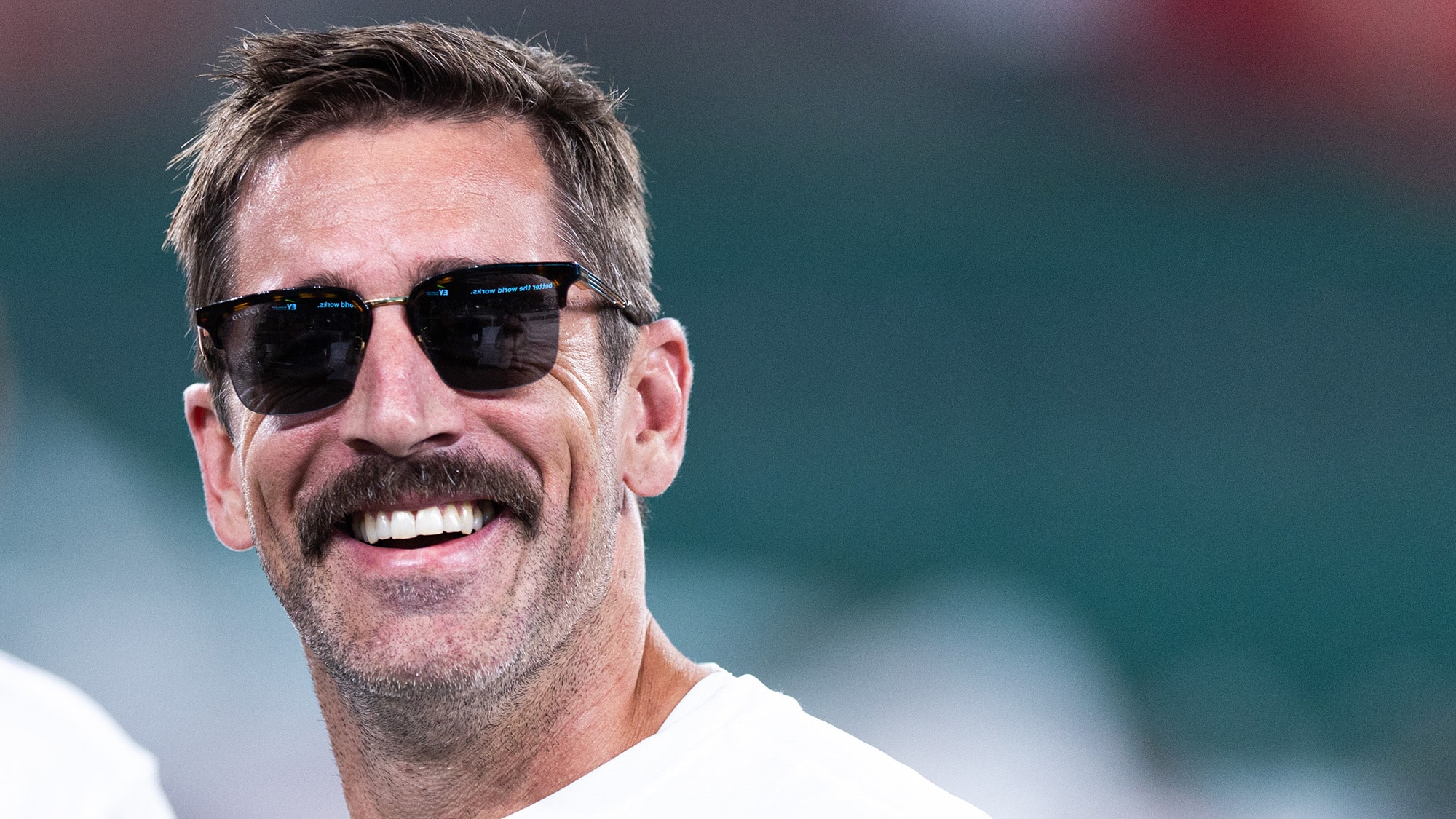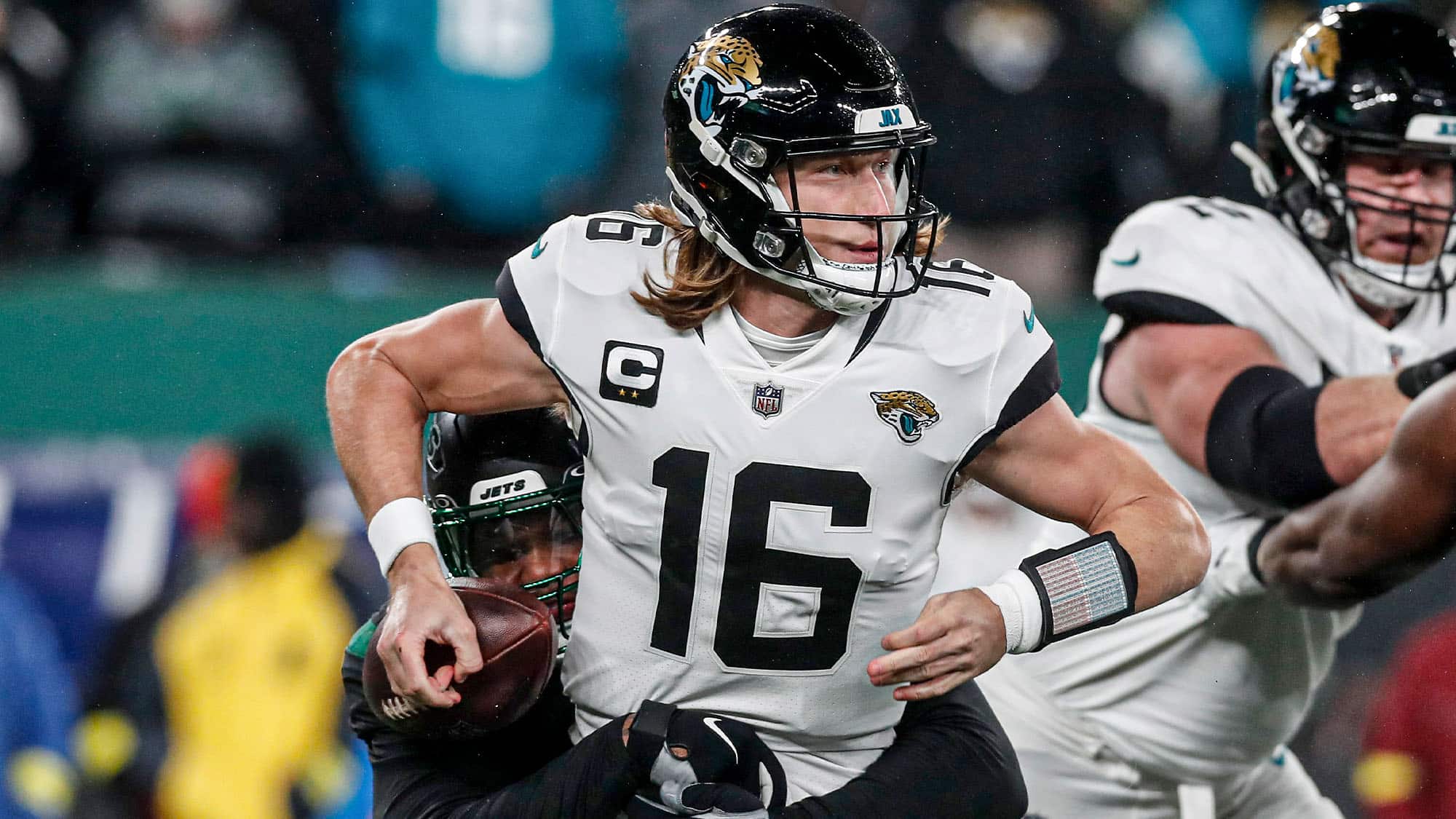Ranking every impending New York Jets free agent according to how much they should be prioritized by Joe Douglas.
Tier 3: Bottom-of-the-barrel players
Many of the New York Jets‘ impending free agents are players who are nowhere near starter-quality. We kick off our list with 12 players who I would consider third-string or practice-squad level.
25. Trevon Coley, IDL
- Free agency type: Unrestricted
- Age on Sept. 1: 27.1
- 2020 cap hit: $145,588
Coley played six games with the Cardinals in 2020 before being waived in December. He was claimed by the Jets on Dec. 14 but did not play a game with the team.
The 2016 undrafted free agent out of Florida Atlantic has been with seven NFL teams in five seasons. He has struggled mightily to produce when on the field, producing 24 career pressures over 809 pass-rush snaps (3.0% rate – 2020 IDL average was 7.0%) and 33 career run stops over 687 snaps against the run (4.8% rate – 2020 IDL average was 6.5%).
24. Josh Andrews, IOL
- Free agency type: Unrestricted
- Age on Sept. 1: 30.2
- 2020 cap hit: $732,358
Andrews logged 311 snaps as a backup interior offensive lineman for the Jets in 2020, playing in eight games and starting four of those (3 at RG, 1 at LG). He was an enormous liability in pass protection, allowing pressure on 13.3% of his protection snaps, the worst rate among qualified guards. His 54.9 run blocking grade at PFF won’t have anybody looking to build a statue of him, either.
23. Ross Travis, TE
- Free agency type: Unrestricted
- Age on Sept. 1: 28.7
- 2020 cap hit: $264,708
Travis only played one game for the Jets in 2020, taking the field for three offensive snaps and seven special teams snaps. Over his five-year career, he has 14 catches for 142 yards in 25 games, playing 17 games with the Chiefs from 2016-17 and seven with the Colts from 2017-19.
22. Bennett Jackson, CB
- Free agency type: Unrestricted
- Age on Sept. 1: 30.0
- 2020 cap hit: $298,529
Jackson is 30 years old and has been in the NFL since being drafted by the Giants in the sixth round of the 2014 draft, yet he has barely played, appearing in just 10 games and logging only 28 defensive snaps.
It’s a small sample size, but Jackson has been great on special teams in his limited time on the field. He has made four tackles over 63 punt and kickoff coverage snaps without missing any. His career PFF special teams grade is 81.3.
21. Frank Gore, RB
- Free agency type: Unrestricted
- Age on Sept. 1: 38.3
- 2020 cap hit: $750,000
The Jets should not be considering bringing back Gore. An infusion of pass-catching ability and game-breaking speed is what the Jets need at the running back position, and Gore provides neither.
Gore averaged only 3.5 yards per carry in 2020, which ranked 44th out of 47 qualified running backs. He was a clear net-negative, as all other running backs on the Jets combined to average 4.3 yards per carry.
Gore’s longest run of the season was 17 yards, the shortest long-run of any player with at least 100 carries.
In the passing game, Gore was a non-factor as he caught 16 of 19 targets for just 89 yards, zero touchdowns, and three first downs. His average of 5.9 receiving yards per game was a career-low.
20. Bryce Hager, LB
- Free agency type: Unrestricted
- Age on Sept. 1: 29.3
- 2020 cap hit: $397,062
Hager was released by the Raiders in August, and the Jets added him to their practice squad in late-September. He wound up playing 10 games for the Jets, mostly appearing on special teams.
Hager was called upon to start at linebacker from Weeks 16-17 due to Harvey Langi’s injury, and he struggled big-time. Across those two games against the Browns and Patriots, Hager missed four tackles, and in coverage, he allowed 11-of-12 passing for 125 yards, two touchdowns, and no interceptions.
On special teams, Hager appeared regularly for the kickoff, kickoff return, punt, and punt return units. He made five tackles and missed three while posting an overall PFF special teams grade of 63.6.
19. Kyron Brown, CB
- Free agency type: Exclusive Rights
- Age on Sept. 1: 25.3
- 2020 cap hit: $425,000
Brown spent the majority of the 2020 season on the reserve/physically unable to perform (PUP) list.
A 2019 undrafted free agent signing by the Jets out of Akron, Brown played three games in 2019, appearing only once on defense, a Week 14 start against the Dolphins in which he allowed 4-of-6 passing for 44 yards and three first downs over 36 snaps in coverage. One of the incompletions was a drop by Albert Wilson (and a bad throw by Ryan Fitzpatrick) in which Brown was toasted for what would’ve been a gain of around 15 yards.
In the 2019 preseason, Brown played one game, the opener against the Giants. He played 25 snaps in coverage and allowed 3-of-4 passing for 35 yards and two first downs.
Brown is an exclusive rights free agent, which means the Jets can offer him a one-year deal at the league minimum that would leave Brown unable to negotiate with any other teams, essentially forcing him to take that deal.
18. Pat Elflein, IOL
- Free agency type: Unrestricted
- Age on Sept. 1: 27.2
- 2020 cap hit: $180,529
Elflein played one game for the Vikings in 2020 until a thumb injury landed him on injured reserve. He returned in November and was waived the next day, soon being claimed by the Jets.
With Alex Lewis out of action, Elflein started at left guard from Weeks 12-17. He was quite poor, tying for second among all guards with 19 pressures allowed over the final six weeks of the season. On the year, his allowed pressure rate of 10.0% was better than only Josh Andrews.
Elflein was hardly better in the run game. When rushing in the left guard’s direction from Weeks 12-17 (as designated by the official play-by-play log), the Jets averaged 3.7 yards per carry and recorded a first down or touchdown on only 14.1% of their rush attempts (2020 league averages on rushes to LG: 4.4, 24.3%).
17. Daniel Brown, TE
- Free agency type: Unrestricted
- Age on Sept. 1: 29.3
- 2020 cap hit: $750,000
Brown played in every game for the Jets from 2019-20. Offensively, he was rather useless, catching nine passes for 103 yards and one touchdown. He even struggled as a blocker, posting a PFF run blocking grade of 48.3 across both seasons (2020 TE average: 61.4). Brown played only 21 offensive snaps (1.3 per game) in 2020 after playing 186 snaps (11.6 per game) in 2019.
Brown has been a core special teams player for the Jets. He led the team in special teams snaps in each of the past two seasons, playing 299 in 2019 and 330 in 2020. Brown routinely appeared on every special teams unit except for the field goal block unit.
However, despite his integral role, Brown never stood out as a special teams player on an individual level over the past two seasons. His PFF special teams grade of 60.4 over the past two seasons falls below the 2020 league average (62.5). He made 11 tackles and missed five, a 2.2-to-1 ratio that is also below the 2020 NFL average for special teams players (2.9-to-1).
16. Jeff Smith, WR
- Free agency type: Exclusive Rights
- Age on Sept. 1: 24.4
- 2020 cap hit: $572,939
Smith’s 2020 season began with an impressive return game against the Broncos in Week 4 as he caught 7-of-9 targets for 81 yards, but over his next 11 games, he was one of the worst receivers in football. From Weeks 5-17, Smith caught 10 of 29 passes for 86 yards over 154 routes run. His average of 0.56 yards per route run over that span ranked 109th out of 110 wide receivers at least 150 routes run.
Still only 24 years old when the season begins and just a few years removed from making the transition from quarterback to wide receiver, Smith could still have some untapped potential. Since Smith is an exclusive rights free agent, the Jets can bring him back with ease if they so desire. If the Jets offer him a one-year contract at the league minimum, he cannot negotiate with other teams.
15. Matthias Farley, S
- Free agency type: Unrestricted
- Age on Sept. 1: 29.3
- 2020 cap hit: $1,218,750
Farley was called upon to play major snaps at safety over the final four games of the season, collecting 196 snaps from Weeks 14-17 (49.0 per game). The results were mixed. His coverage numbers appear dominant at first glance, as he allowed 2-of-10 passing for 13 yards with two pass breakups, but both of the completions were touchdowns. In addition, his tackling was downright horrendous, as he missed six tackles against only 14 converted tackles for a gruesome miss rate of 30.0% (2020 safety average: 11.7%).
Farley is a highly experienced special teams player with 1,155 career snaps in the phase, contributing to every unit on a consistent basis except for the field goal protection unit.
Missed tackles have been an issue for Farley on special teams. He led the Jets with eight special teams tackles in 2020 and had six in 2019, but he had four whiffs in each season, giving him 14 tackles and eight misses on special teams as a Jet, a poor 1.8-to-1 ratio. His overall PFF special teams grade as a Jet is 57.2.
14. Harvey Langi, LB
- Free agency type: Restricted
- Age on Sept. 1: 28.9
- 2020 cap hit: $714,711
Langi was called upon to play an every-down linebacker role in seven games for the Jets, and he had an extremely rough time in his first career action as a core defensive player. On the season, his overall defensive PFF grade of 34.9 ranked 95th out of 99 qualified linebackers. Missed tackles were a key issue as his missed tackle rate of 16.4% was well above the 2020 positional average of 10.7%.
Playing in 30 of 32 games for the Jets from 2019-20, Langi was an essential special teams player as he logged 267 special teams snaps in 2019 and 239 in 2020, appearing on every unit save for the field goal protection unit. He is an excellent blocker for the return units, but he struggled in coverage with seven tackles and five missed tackles, a 1.4-to-1 ratio that is less than half of the 2020 league average for special teams players.
In 2020, Langi made just one tackle to two misses over 76 snaps in punt and kickoff coverage, earning an abysmal 42.7 PFF special teams grade.
Tier 2: Backup-quality players
These players can offer a solid amount of value, but should not be considered as possible starters.
13. Bradley McDougald, S
- Free agency type: Unrestricted
- Age on Sept. 1: 30.8
- 2020 cap hit: $4,068,750
McDougald was a solid starter throughout the majority of his NFL career, but he crashed down hard in 2020, his first season on the darker side of 30 years old. His 41.0 overall PFF grade was the fourth-worst among qualified safeties.
Teams threw 16 passes in McDougald’s direction and completed 13 of them for 216 yards, an eye-popping 13.5 yards per target. He was also poor against the run, giving up quite a few big plays due to poor angles and recognition. His 48.2 run defense grade at PFF ranked at the 13th percentile among qualified safeties.
In my ranking of 31 free agent safeties based on an agglomeration of key statistics, McDougald landed at No. 30.
12. Frankie Luvu, EDGE
- Free agency type: Restricted
- Age on Sept. 1: 24.9
- 2020 cap hit: $560,588
Luvu played 257 snaps at outside linebacker for the Jets in 2020 and was quite decent for the most part. As a pass rusher, he had 10 pressures over 109 pass-rush snaps, giving him a pressure rate of 9.2% that was slightly below the positional average of 9.7%. Against the run, Luvu had nine stops over 96 snaps for a very good rate of 9.4%, scorching the positional average of 5.8%.
The two areas where Luvu struggled: tackling and coverage. Luvu had a missed tackle rate of 20.0%, a few notches above the 2020 EDGE average of 15.5%. In coverage, Luvu was asked to drop back on 52 snaps, and teams went after him on those occasions. He allowed 10-of-11 passing in his direction for 88 yards, two touchdowns, four first downs, and no interceptions. That’s 8.0 yards per target, 1.69 yards per cover snap, and a conversion on 54.5% of targets.
Luvu also contributes heavily on special teams with 626 snaps in that phase for the Jets since 2018. He is a missed tackle machine with 13 tackles to 10 misses but provides quality blocking for the kickoff and punt return units. Even with all of those missed tackles, he has an overall PFF special teams grade of 65.6 in his three-year Jets career – a testament to his contributions in unheralded areas such as his aforementioned blocking for the return teams.
11. Vyncint Smith, WR
- Free agency type: Restricted
- Age on Sept. 1: 25.2
- 2020 cap hit: $661,766
For whatever reason, Adam Gase phased Smith out of the offensive gameplan in 2020 despite a promising second half of the 2019 season for the German-born speedster.
From Weeks 12-17 of 2019, Smith averaged 2.2 catches for 31.7 yards and 1.5 first downs over only 19.5 routes run per game (52.2% of the Jets’ passing plays). His average of 9.5 yards per target placed at the 78th percentile among wide receivers over that span, while his average of 1.62 yards per route run placed at the 53rd percentile. With nine first downs on 20 targets, the Jets moved the chains 45.0% of the time when throwing Smith’s way.
Then, 2020 comes along, and Smith is given just 50 offensive snaps – only 31 of those in the passing game – over seven games. He caught only one pass for 13 yards.
Smith also showed a lot of promise as a kickoff returner in 2019, averaging 29.9 yards per return over 10 returns. He only got two kickoff return opportunities in 2020 (averaging 11.5 yards).
I would still like to see more from Smith, at least in the return game if there is no room for him on offense. It was shocking to see Gase completely ignore Smith after he showed a lot to like near the end of 2019.
10. Neville Hewitt, LB
- Free agency type: Unrestricted
- Age on Sept. 1: 28.4
- 2020 cap hit: $2,000,000
Hewitt had a nice season of downhill play-making in 2020, but he simply doesn’t fit what the Jets need going forward. C.J. Mosley will man the MIKE linebacker spot, which is the role Hewitt handled in Mosley’s absence. Next to Mosley, the Jets need a rangy, fluid athlete who can cover effectively, and Hewitt is the polar opposite of that.
Over the course of his career, Hewitt owns a composite PFF coverage grade of 48.0, a terrible mark. His 55.2 coverage grade in 2020 was his best since a small-sample 2015 rookie season and stands out as a major outlier compared to the rest of his career, and yet it still ranked at only the 44th percentile among linebackers.
In the modern NFL, the most essential trait for a starting linebacker is coverage ability, and Hewitt does not have it. As a zone defender, he’s a spot-dropper who simply runs to his spot and does not have the natural instincts that allow him to instinctively react to his surroundings and neutralize the threats in his area. In man coverage, he is too slow and sluggish to hang with either running backs or tight ends.
Let’s be clear, though: Hewitt can still have value to the Jets as a backup. He is a good blitzer, decent run defender, and strong special teams player, so there is a place for him on the Jets or any team. As a pass rusher, his career pressure rate of 16.8% is above the 2020 average for linebackers (14.3%). Against the run, he had a 64.2 PFF run defense grade in 2020 that ranked at the position’s 77th percentile (although he only graded at a 44.5 against the run in 2019, 14th percentile). On special teams, he has 30 career tackles to just four missed tackles, 7.5-to-1 ratio.
Bringing back Hewitt as the second-string MIKE linebacker would make sense. Penciling him in as a starter or signing him to anything more than backup-level money would probably not be a great idea.
9. Patrick Onwuasor, LB
- Free agency type: Unrestricted
- Age on Sept. 1: 29.0
- 2020 cap hit: $2,000,000
Onwuasor played just one game for the Jets in 2020, logging eight special teams snaps against the Chargers in Week 11. He was on injured reserve due to a knee injury for the team’s first nine games until a hamstring injury in Los Angeles landed him on injured reserve for the ensuing six games.
While Onwuasor should not be expected to be a starter, his skill-set is a decent fit for the Jets’ needs as they transition to a 4-3 scheme and look to address their lack of ranginess and coverage talent at linebacker. Athleticism is the basis of the six-foot, 227-pounder’s game.
However, Onwuasor’s career production in coverage is all over the place. In 2019, he was brutal, allowing 33-of-37 passing for 390 over just 217 coverage snaps. That’s 10.5 yards per target and 1.80 yards per cover snap – the 2020 averages for linebackers were 7.3 and 0.96.
On the contrary, in 2018, Onwuasor was a monster in coverage, dropping back on 210 snaps and allowing 20-of-26 passing for 151 yards – measly numbers of 5.8 yards per target and 0.72 yards per cover snap.
I hesitate to rank Onwuasor any higher than this due to his major injury question marks and abhorrent 2019 production, but his skill-set fits what the Jets need and his 2018 season showcased the exact type of play that they will be looking for in their linebacker additions over the next few months. He could certainly be retained and utilized as a key sub-package player.
Onwuasor also has a great special teams background, making 17 career tackles in coverage while missing only one. He has an excellent career PFF special teams grade of 70.7.
8. Jordan Jenkins, EDGE
- Free agency type: Unrestricted
- Age on Sept. 1: 27.2
- 2020 cap hit: $3,937,500
Jenkins is better than some of the players listed above him here, but he just doesn’t seem like a great fit for the Robert Saleh/Jeff Ulbrich defense. He isn’t agile enough to play 4-3 outside linebacker, and he also isn’t big enough to handle a 4-3 defensive end role with regularity.
Jenkins’ five years as a Jet were defined by consistently average play. His career pressure rate of 10.3% (148 pressures on 1,441 pass-rush snaps) is slightly above-average for the position (9.7% was the 2020 EDGE average). His career run stop rate of 5.0% (62 run stops over 1,250 run defense snaps) is slightly below-average for the position (5.8% was the 2020 EDGE average). Nothing great, nothing terrible.
The best single-season pressure total posted by Jenkins was a mark of 35 in 2018 that tied him for 50th among edge defenders. He could never quite leap any further than pedestrian-level.
7. Tarell Basham, EDGE
- Free agency type: Unrestricted
- Age on Sept. 1: 27.5
- 2020 cap hit: $825,000
Basham suffers a similar fate to Jenkins in terms of scheme fit and is also a generally average player on the whole, but he offers a bit more versatility.
Jenkins does not offer special teams value. He played 138 snaps in that phase over the past two seasons, but 116 were on the field goal block team, so he doesn’t contribute much of anything for the return and coverage teams. Basham offers a lot more on special teams, playing 306 special teams snaps over the past two seasons as he frequently appeared for every unit other than the field goal protection unit. He has a 3.0-to-1 career ratio of tackles to missed tackles on special teams.
Basham is also a better all-around athlete than Jenkins. At their respective Combines, Basham ran a 4.7 forty and 7.27 three-cone at 269 pounds while Jenkins ran a 4.8 forty and 7.37 three-cone at 259 pounds. Physical traits don’t define how good a player is, but they are just something to keep in mind when trying to project a player to a new scheme. The more that a player has to offer physically, the more roles he can likely be trusted to handle, increasing his chances of fitting in a wider number of defensive schemes.
From a production standpoint, Basham is about as average as Jenkins. Basham has a 9.6% career pressure rate and 5.0% career run stop rate, two numbers that are very close to Jenkins’ career.
6. Joe Flacco, QB
- Free agency type: Unrestricted
- Age on Sept. 1: 36.6
- 2020 cap hit: $1,275,000
Flacco will likely look for a starting job before settling to become a backup again, but if the Jets can get him back as the backup for another season, I think it would be a win. I liked what Flacco showed in 2020 and think he is about as good as you can hope for in a backup quarterback.
The Jets’ offense was much better across its four games with Flacco under center. In Flacco’s starts, the Jets offense averaged an offensive EPA (estimated points added) of +0.95, similar in quality to the 26th-ranked Bengals offense. In Darnold’s starts, the Jets averaged an offensive EPA of -5.24, more than three times worse than the season average of any of the league’s other 31 teams in 2020 (the Giants’ -1.67 mark was the worst by a non-Jets team).
Flacco doubled up Sam Darnold‘s passing touchdown production, tossing six scores in four starts (1.5 per game) compared to Darnold’s nine scores in 12 starts (0.75 per game). Flacco also had a lower interception rate (2.2% vs. 3.0%) and averaged more net yards per pass attempt (4.95 vs. 5.64).
I was surprisingly impressed by Flacco’s film. He looked like a relatively average quarterback to me. Grading every single one of his plays on the season, I scored him with an overall grade of 50.1 on a scale of 0-to-100. I had Darnold at a 34.1 on the season.
5. Arthur Maulet, DB
- Free agency type: Unrestricted
- Age on Sept. 1: 28.1
- 2020 cap hit: $875,000
Maulet is no superstar in the making. He’s just a very solid depth piece in the defensive backfield who can do a lot of different things, the type of guy that any team would love to have on a cheap deal.
In 2019, Maulet started at outside cornerback for the Jets in six games over the second half of the season and played well, posting a 65.2 overall PFF grade that ranked at the 56th percentile among qualified cornerbacks (200+ snaps). During his stint as a starter, he allowed no touchdowns, one interception, 6.8 yards per target, and 1.11 yards per cover snap.
This past season, Maulet played slot cornerback and safety for the Jets. He struggled with missed tackles, posting a massive miss rate of 24.0%, but he covered solidly with only 6.9 yards per target and 0.83 yards per cover snap allowed (with 2 TDs and 1 INT).
Again, Maulet is no stud, but he’s a versatile, decent depth piece who makes a lot of sense for the Jets to try and bring back on a low-cost contract.
4. Josh Adams, RB
- Free agency type: Restricted
- Age on Sept. 1: 24.8
- 2020 cap hit: $264,708
Adams made the absolute most of his 29 carries with the Jets in 2020, averaging 5.4 yards per carry while picking up two touchdowns and eight first downs. He gained at least five yards on over half of his carries (15 of 29). Most of his production was self-created, as he ranked third among running backs with 4.0 yards after contact per carry.
Just two years earlier, Adams had a solid rookie season for the Eagles at 22 years old, rushing for 36.5 yards per game on 4.3 yards per carry over 14 games.
3. Breshad Perriman, WR
- Free agency type: Unrestricted
- Age on Sept. 1: 28.0
- 2020 cap hit: $6,437,500
Perriman had a hot-and-cold 2020 season with the Jets, posting at least 54 yards in five games and no more than 27 in his other seven. Over 12 appearances, he secured 30 of 60 targets for 505 yards (8.4 yards per target and 42.1 yards per game), 17 first downs, and three touchdowns (33.3% conversion rate).
From an efficiency standpoint, Perriman was a below-average producer across the board:
- 1.36 yards per route run (42nd percentile among qualified WR)
- 18.5 routes run per first down or TD (24th percentile)
- 63.1 overall PFF grade (34th percentile)
- -3.0% DVOA (47th percentile)
It is worth noting that Perriman tied for fifth among wide receivers with five defensive pass interference penalties drawn, totaling 91 yards.
Perriman performed much better in his three games with Joe Flacco than in his nine games with Sam Darnold. With Flacco, Perriman averaged 3.7 catches on 6.3 targets for 72.3 yards, scoring three touchdowns and eclipsing 50 yards in each game. With Darnold, Perriman averaged 2.1 catches on 4.6 targets for 32.0 yards, scoring no touchdowns and surpassing 50 yards only twice.
The Jets need to make sure they emphasize finding an upgrade over Perriman – if he is still one of their three best wide receivers on opening day, they probably didn’t try hard enough – but he is not that bad of a player. As Joe Blewett broke down on film week after week, Perriman was open far more than most fans realized, but he simply wasn’t getting rewarded due to factors beyond his control. He’s a tremendous athlete, strong contested-catch winner and underrated downfield separator.
You can never have enough weapons, and Perriman certainly is one. He brings a few different positive traits to the table, which fans did not get to see enough of since the ball just wasn’t going his way when it should have been. The Jets should certainly think about bringing Perriman back if he can be had affordably.
Once again, though, Perriman cannot be considered a solution, but merely an option as one more weapon to add to the arsenal.
Tier 1: Very good starters
Of the Jets’ 25 impending free agents, these are the only two that could potentially be in great demand on the open market and would be considered a key loss if they signed elsewhere.
2. Brian Poole, CB
- Free agency type: Unrestricted
- Age on Sept. 1: 28.9
- 2020 cap hit: $4,937,500
Poole does not get enough appreciation for how elite he has been over the past two seasons.
Since joining the Jets in 2019, Poole has allowed only 472 yards over 629 snaps in slot coverage. That’s just 0.75 yards per cover snap out of the slot – best in the NFL among the 36 defensive backs with at least 300 slot coverage snaps over the past two seasons. The second-ranked player, D.J. Hayden, has a mark of 0.90. The 0.15 difference between Poole and Hayden is greater than the difference between Hayden and 12th-ranked Cameron Sutton (1.01).
In total, Poole has covered on 778 snaps over 23 games for the Jets and has given up just one touchdown against three interceptions. The 93 passes thrown his way have totaled 505 yards, a minuscule 5.4 yards per target.
Here are some of Poole’s rankings among all cornerbacks from 2019-20.
Fewest yards per target allowed (minimum 60 targets):
- Richard Sherman (4.8)
- Jimmy Smith (4.9)
- Darqueze Dennard (5.4)
- Brian Poole (5.4)
- Jamel Dean (5.5)
Fewest yards per cover snap allowed (minimum 500 cover snaps):
- Richard Sherman (0.41)
- Jimmy Smith (0.61)
- Brian Poole (0.65)
- Jalen Ramsey (0.77)
- Jason McCourty (0.78)
Best overall PFF grade (minimum 1,000 snaps):
- Richard Sherman (83.2)
- Jaire Alexander (81.2)
- Darious Williams (79.8)
- Xavien Howard (79.4)
- Brian Poole (78.3)
On tape, Poole’s excellent play recognition, top-end closing speed, and sound tackling all pop out. It is a mystery as to why he was not rewarded with a large deal in free agency last year. Perhaps he will cash in this year after proving his 2019 season was no fluke.
Inking a 29-year-old cornerback to a lucrative long-term deal should give any team pause, but there is simply no slot cornerback in the world who offers a better track record of production than Poole. The Jets – and every team with a need in the slot – should be willing to shell out a good amount of dough to keep him around. Perhaps not too much given his age and recent injury history, but this is an elite player we’re talking about here. He has a good chance of providing a strong return-on-investment for his new team even if he comes at a high cost.
1. Marcus Maye, S
- Free agency type: Unrestricted
- Age on Sept. 1: 28.5
- 2020 cap hit: $2,085,378
Maye had a fantastic all-around season in 2020 as he posted the fourth-best overall PFF grade among safeties (82.9) while tying for fourth at the position with 11 passes defended.
In Week 6, Maye returned to primarily lining up at free safety after largely playing in the box over the first five games. From Weeks 6-17, his PFF grade ballooned to 89.3, second-best among safeties over that span (behind Adrian Amos).
The Jets could consider using the franchise tag on Maye, which Over The Cap estimates will be worth about $11.2 million for safeties this season.
However, it would probably make sense for the Jets to simply get to work on extending Maye as soon as possible. While he is about to turn 28 years old, Maye has proven capable of providing well-above-average play on a yearly basis and just elevated his game to an elite level. He is one of the few valuable pieces on the roster and would likely not be as easy to replace as many seem to think he would be. He boasts excellent football IQ, instincts, fundamentals, and coverage technique, four traits that are crucial at the safety position and cannot be found in a player scooped off the scrapheap. Not to mention, Maye is a highly respected team leader who can be an integral part of establishing a refreshed culture under Robert Saleh.
Spotrac projects the Jets to have the second-most cap space in the NFL at $75,532,774. The Jets don’t have much to do with that cap space regarding the players on their own roster – we just ran through a 25-player list of impending free agents that includes only one other player who is undoubtedly an above-average starter, and among the players under contract, nobody is even close to being considered for a long-term extension just yet (even Quinnen Williams is probably two years away).
This team should have no issue swallowing an expensive long-term deal for one of its best players and most established leaders.

